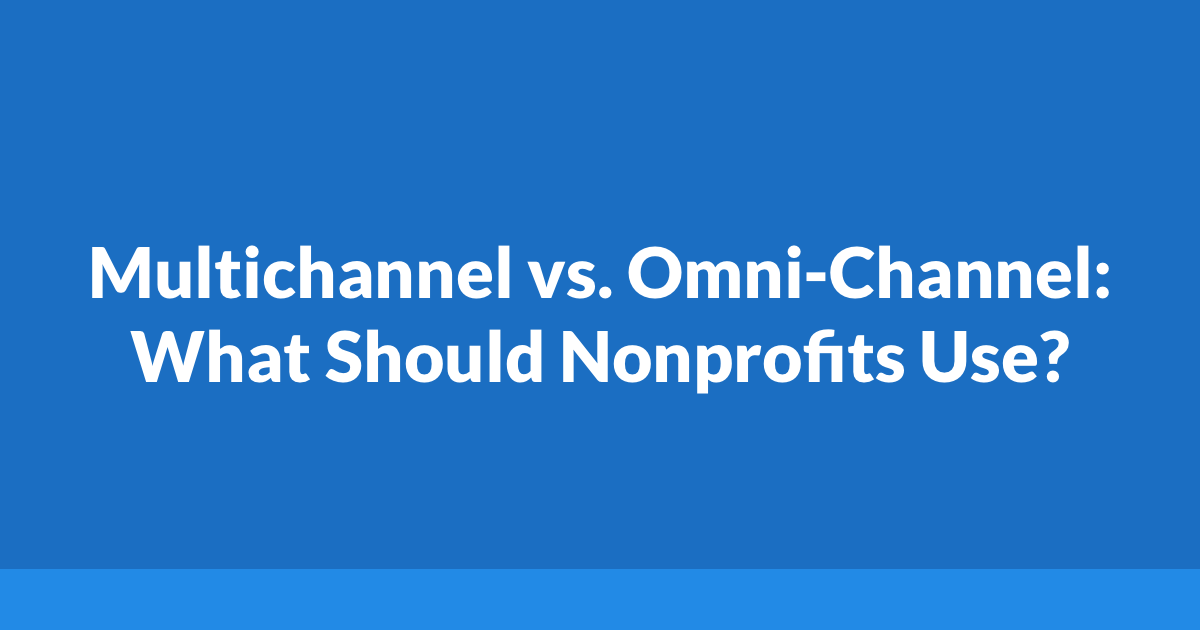Multi-Channel vs Omni-Channel: What Should Nonprofits Use?

There’s no shortage of communication channels for nonprofits to use to engage with supporters. From direct mail to email, from social media to digital ads, from telephone calls to text messaging, and beyond, nonprofit marketers aiming to grow their base and increase their revenue have many options for diversifying their outreach methods. Even with a wide array of channels, however, the way in which they are used together makes all the difference. In this blog post, we’ll talk about two ways of coordinating between multiple means of marketing: a multichannel approach and an omni-channel approach, and compare the effectiveness of each.
What are multi-channel marketing and omni-channel marketing?
Multi-channel marketing
Multi-channel marketing is the practice of applying a single strategy across the different communication channels that an organization uses, including both digital and traditional. Multi-channel marketing can be thought of as a static, linear strategy that begins with the brand and moves outward to channels. The primary idea and goal behind implementing multichannel marketing is to give the audience a choice and to allow multiple locations for interaction.
Omni-channel marketing
Omni-channel marketing is the cohesive integration of all communication channels that an organization uses, both digital and traditional, to provide a seamless, unified experience for your audience. Omni-channel marketing can thought of as a dynamic, complex strategy that begins with the audience and builds communication based on their engagement. The primary idea and goal behind implementing omni-channel marketing is to continually update what your supporters are seeing.
How are the two different?
Multi-channel and omni-channel marketing are often used interchangeably. However, they are not the same. How can you tell the difference between the two? One easy way is to observe how the two contrast when it comes to the relationship between their respective messaging and overall strategy. While both strategies incorporate multiple channels into communication with supporters, the distinguishing factor lies in the details.
In a multi-channel approach, the communication to the audience between each channel remains largely unchanged. This means that if a supporter sees messaging from multiple channels it may be duplicative, rather than building on itself and moving them further along the donor journey. With an omni-channel approach, the messaging meets the audience where they are, which not only includes which channel they’re using, but also considers which particular stage of the donor journey they’re at.
Simply put, multi-channel marketing is talking to your supporters, while omni-channel marketing is having an active conversation with your supporter. In any decent conversation, listening is as important of a component as is speaking.
Which strategy is more effective?
Think of omni-channel marketing as an evolution. Technology has allowed us to develop capabilities beyond the limited approach of multi-channel marketing, scaling up our efforts with deeper personalization. We can clearly see this through the perspective of the prospective donor: if you received the same message over and over again, especially if it’s one that hasn’t particularly resonated with you, you might end up feeling disconnected and disengaged.
If you don’t meaningfully engage with supporters, nonprofits run the risk of creating a sense of donor fatigue. This can lead to losses in strong relationships with donors, both potential and existing, who generously contribute to your mission. Obviously, no one wants that, so how can you make sure your organization is capable of overcoming it all?
The approach you take, when it comes how you communicate with supporters, impacts donor fatigue and its prevention. The numbers show that omni-channel marketing matters when it comes to keeping supporters engaged. Instead of disrupting their journey, marketers and fundraisers should commit to observing, understanding, and anticipating who the supporter is, what steps they’ve taken on their specific journey, and where they’re trying to go.
At each touchpoint, an omni-channel campaign updates its messaging based on how the audience engages. This method provides information that is both relevant and convenient, which are useful in eliminating barriers between a potential supporter and your organization.
Through active listening and omni-channel marketing, nonprofits can empower themselves with the game-changing advantage of incorporating a detailed level of personalization that emphasizes the experience of the individual — and this can be less possible using the multi-channel model.


